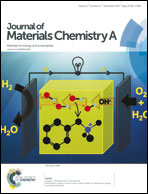Supercapacitive properties of coiled carbon nanotubes directly grown on nickel nanowires†
Abstract
In this paper, Coiled carbon nanotubes (CNTs) have been grown directly on an anodized aluminum oxide (AAO) template by using catalytic chemical vapor deposition (CVD). The nanochannels of the AAO template, which is covered on one side with a conducting Au layer, were filled by using Catalytic Ni nanowires (Ni-NWs). Scanning electron microscopy (SEM/EDX) and Raman spectroscopy were used to prove the formation of coiled CNTs on Ni-NWs. Cyclic voltammetry, galvanostatic charge–discharge, and impedance spectroscopy were used to investigate the capacitive behavior of the coiled CNT/Ni-NW. Electrochemical analysis revealed that as electrodes for supercapacitors the coiled CNT/NW porous structured materials exhibit a high specific capacitance (202 F g−1 at a current density of 10 A g−1) as well as excellent cycle stability and can retain more than 92% of the initial response after 6000 cycles. On the other hand as prepared coiled CNT/Ni-NW electrode worked over a wide potential window (2.1 V) in 1 M Na2SO4 aqueous solution at room temperature. Combining the specific capacitance with the large electrochemical window ensures the superior energy and power densities of nanostructure electrodes, which would be useful to improve the performance of new energy storage technologies.


 Please wait while we load your content...
Please wait while we load your content...